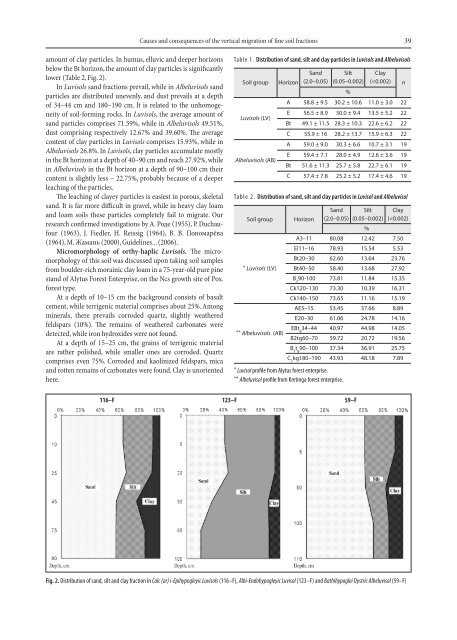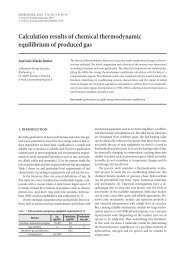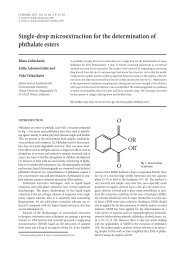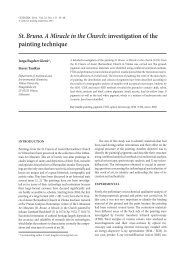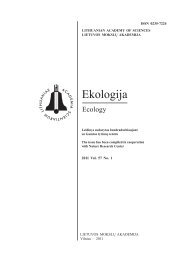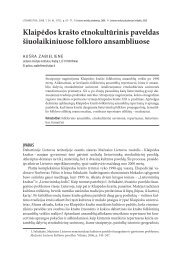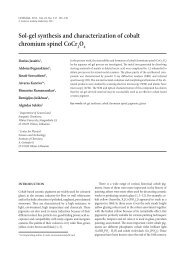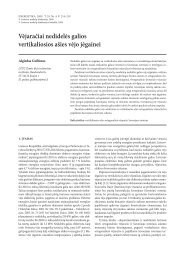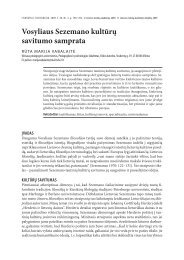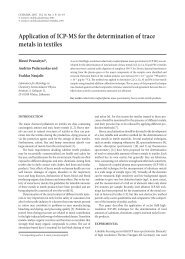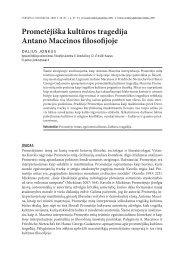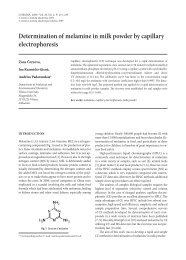Causes and consequences of the vertical migration of fine soil ...
Causes and consequences of the vertical migration of fine soil ...
Causes and consequences of the vertical migration of fine soil ...
You also want an ePaper? Increase the reach of your titles
YUMPU automatically turns print PDFs into web optimized ePapers that Google loves.
<strong>Causes</strong> <strong>and</strong> <strong>consequences</strong> <strong>of</strong> <strong>the</strong> <strong>vertical</strong> <strong>migration</strong> <strong>of</strong> <strong>fine</strong> <strong>soil</strong> fractions 39<br />
amount <strong>of</strong> clay particles. In humus, elluvic <strong>and</strong> deeper horizons<br />
below <strong>the</strong> Bt horizon, <strong>the</strong> amount <strong>of</strong> clay particles is significantly<br />
lower (Table 2, Fig. 2).<br />
In Luvisols s<strong>and</strong> fractions prevail, while in Albeluvisols s<strong>and</strong><br />
particles are distributed unevenly, <strong>and</strong> dust prevails at a depth<br />
<strong>of</strong> 34–44 cm <strong>and</strong> 180–190 cm. It is related to <strong>the</strong> unhomogeneity<br />
<strong>of</strong> <strong>soil</strong>-forming rocks. In Luvisols, <strong>the</strong> average amount <strong>of</strong><br />
s<strong>and</strong> particles comprises 71.59%, while in Albeluvisols 49.51%,<br />
dust comprising respectively 12.67% <strong>and</strong> 39.60%. The average<br />
content <strong>of</strong> clay particles in Luvisols comprises 15.93%, while in<br />
Albeluvisols 26.8%. In Luvisols, clay particles accumulate mostly<br />
in <strong>the</strong> Bt horizon at a depth <strong>of</strong> 40–90 cm <strong>and</strong> reach 27.92%, while<br />
in Albeluvisols in <strong>the</strong> Bt horizon at a depth <strong>of</strong> 90–100 cm <strong>the</strong>ir<br />
content is slightly less – 22.75%, probably because <strong>of</strong> a deeper<br />
leaching <strong>of</strong> <strong>the</strong> particles.<br />
The leaching <strong>of</strong> clayey particles is easiest in porous, skeletal<br />
s<strong>and</strong>. It is far more difficult in gravel, while in heavy clay loam<br />
<strong>and</strong> loam <strong>soil</strong>s <strong>the</strong>se particles completely fail to migrate. Our<br />
research confirmed investigations by A. Роде (1955), P. Duchaufour<br />
(1963), J. Fiedler, H. Reissig (1964), В. В. Понoмaрёва<br />
(1964), M. Жамань (2000), Guidelines... (2006).<br />
Micromorphology <strong>of</strong> orthy-haplic Luvisols. The micromorphology<br />
<strong>of</strong> this <strong>soil</strong> was discussed upon taking <strong>soil</strong> samples<br />
from boulder-rich morainic clay loam in a 75-year-old pure pine<br />
st<strong>and</strong> <strong>of</strong> Alytus Forest Enterprise, on <strong>the</strong> Ncs growth site <strong>of</strong> Pox.<br />
forest type.<br />
At a depth <strong>of</strong> 10–15 cm <strong>the</strong> background consists <strong>of</strong> basalt<br />
cement, while terrigenic material comprises about 25%. Among<br />
minerals, <strong>the</strong>re prevails corroded quartz, slightly wea<strong>the</strong>red<br />
feldspars (10%). The remains <strong>of</strong> wea<strong>the</strong>red carbonates were<br />
detected, while iron hydroxides were not found.<br />
At a depth <strong>of</strong> 15–25 cm, <strong>the</strong> grains <strong>of</strong> terrigenic material<br />
are ra<strong>the</strong>r polished, while smaller ones are corroded. Quartz<br />
comprises even 75%. Corroded <strong>and</strong> kaolinized feldspars, mica<br />
<strong>and</strong> rotten remains <strong>of</strong> carbonates were found. Clay is unoriented<br />
here.<br />
Table 1. Distribution <strong>of</strong> s<strong>and</strong>, silt <strong>and</strong> clay particles in Luvisols <strong>and</strong> Albeluvisols<br />
Soil group<br />
Luvisols (LV)<br />
Albeluvisols (AB)<br />
Horizon<br />
S<strong>and</strong><br />
(2.0–0.05)<br />
Silt<br />
(0.05–0.002)<br />
%<br />
Clay<br />
(


